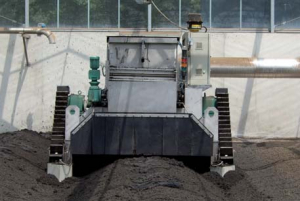Water treatment facility gains improved communications
A major company known for engineering, building, and managing water treatment plants was faced with a new challenge.
At a French treatment facility designed by the company, an innovative method was implemented for a common wastewater treatment application involving sludge drying.
The sludge drying process is a residual element of the application that takes place once water has been cleaned and decanted.
Radios and robots
In the solar sludge drying process developed by a subsidiary of the manufacturer, sludge is treated by a centrifuge and laid out in windrows in a greenhouse heated by solar radiation. An automated robotic turner is used to aerate the sludge and accelerate water evaporation. The robots are radio-controlled, which provides a more robust solution than the traditional wired approach. With wireless control of the robots, the entire operation is automated, and there is no further need for operators to enter the greenhouse.
The company decided to attach radios to the robots to enable information to be sent to and from the control station. This means the operator can control the robot remotely, program its movements, and know its current position. The robot has an onboard controller that interfaces with the radio.
“Implementation proved to be very simple, thanks in particular to ProSoft Technology’s technical support,” explained a representative of the system integrator. “As far as the choice of supplier was concerned, we stuck to the specifications given by RG2I, their local distributor. Our major concern was reliability. We had to have a reliable solution, with none of our users encountering any problems. This is indeed the case with ProSoft Technology´s wireless solution.”
So far, ProSoft Technology radios have been installed at half a dozen of the company´s sites.
A reliable transmission system
The wireless solution brought all of the advantages of wireless connection to industrial automation applications, while still offering high levels of reliability. In addition to its ability to withstand harsh operating conditions, it also improves the transmission of Ethernet data packets.
The standards set out in IEEE 802.11 (commonly known as “Wi-Fi”) bring an extremely high level of security, flexibility, and interoperability to industrial automation applications. Originally designed for office and home applications, these less-robust technologies have limitations when it comes to industrial protocol transfer, resulting in transmission problems for industrial automation systems associated with the radio transmission method used for Ethernet packets. But ProSoft’s wireless solutions ensure optimal transfer of data packets. To improve data packet transfer, the radios use a specific signal processing algorithm implemented by ProSoft Technology, which allows better use of the full bandwidth and supports the fast data transmission speeds demanded by industrial automation engineers. This is particularly vital for industrial applications (involving protocols such as EtherNet/IP™) with a need to transport non-critical messaging data but also critical industrial I/O data.
With its “Power over Ethernet” (PoE) specification, the power supply and connection of the radio system to the wired Ethernet is done via a single cable (instead of two), which greatly simplifies installation and reduces set-up times. Another valuable function of the wireless solution is that it supports serial encapsulation, which means that serial peripherals can be used and integrated into the main Ethernet architecture of the control system. The radio used in this application ensures high performance for both 2.4 GHz and 5 GHz band configurations.
These wireless solutions are ideal for industrial applications: industrial grade enclosures, extended operating temperature ranges, compliance with shock and vibration resistance standards, certification for use on sites where there is a risk of explosion, fitting to DIN rails, and more. These factors were important to the system integrator in their decision to select a ProSoft wireless solution for their application.
To learn more about ProSoft Technology’s Wireless Solutions, click here.




